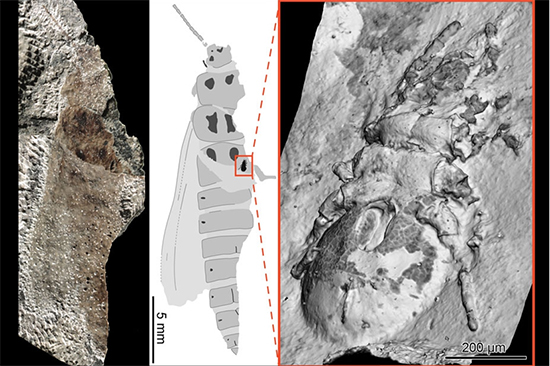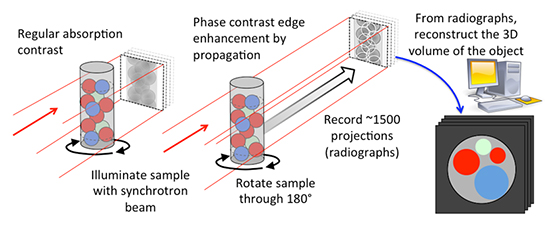More than 320 million years ago, an insect of an extinct group of grasshopper and carrying a minute mite on its back was rapidly buried, and then fossilised. Recently, both fossil animals were recovered in a Chinese deposit, and the fossil mite has been studied for details at SOLEIL by an international scientific team (China, Russia and France). Phase contrast microtomography at the PSICHÉ beamline was used to visualise in three dimensions the 0.8 mm long mite, revealing details of its anatomy. These morphological details and the position of the mite (on the wings) suggest a phoretic association, that is to say that the grasshopper transported the mite, without getting any benefit or disadvantage from this association. This is the earliest case of symbiosis between a mite and a larger animal ever observed, revealing the antiquity of such interactions.
This study took advantage of the synchrotron light and of the performances of the tomograph of the PISCHÉ beamline, which has been in user operation since September 2014. Although the instrument has been optimized for materials science experiments (composite or structured materials, corrosion, fatigue or deformation, batteries…), this example shows it is not limited to these applications.

Figure 1: The 320million years-old grasshopper and mite. Left: Fossil photograph, Center: Interpretative drawing showing the position of the mite on the insect, Right: Phase contrast tomography of the mite. © MNHN - Ninon Robin / Olivier Béthoux / Damien Germain / Andrew King
Phase contrast tomography uses the same principles as a medical scanner. The sample is placed on a rotation stage, and the x-ray beam forms a projection image or radiograph on a detector. A series of images (often 1500) is taken while rotating the sample through 180 degrees, in order to see the object from all directions. A computer takes these projection images and reconstructs the 3D structure of the object. This allows seeing inside the solid object. This is very important for valuable or unique samples – like fossils – that must not be physically cut. For materials science, it is important for studying samples that are changing with time, for example batteries, or materials under stress.

Figure 2: Principle of tomography, using absorption (left) or phase contrast (right). In both cases, the 3D volume is reconstructed from the ∼1500 radiographs.
Compared to a medical scanner, the PSICHÉ beamline has much greater resolution and sensitivity – like a microscope compared to a normal camera. The special properties of the synchrotron beam allow using phase contrast, giving greater sensitivity than absorption commonly used in radiography. The synchrotron light is very intense and partially spatially coherent, meaning that the light waves at different positions in the beam are in phase with each other. When passing through the sample the waves are shifted, creating interference effects on the detector, which is in this case placed at an optimal distance for contrast. Small variations in density of the sample can be detected more easily in this way. This allows studying very small samples like this 320 million year old mite, which was less than one millimeter long.
In 2017, the PUMA beamline, dedicated to ancient materials, will be open to users at SOLEIL. They will be able to probe their objects by tomography, as done on PSICHÉ today, and this shall, for sure, lead to other exciting discoveries …
These results were obtained by the collaboration:
- Centre de Recherche sur la Paléobiodiversité et les Paléoenvironnements (CR2P, UMR 7207), Sorbonne Universités, MNHN, CNRS, UPMC-Paris6, Muséum National d’Histoire Naturelle, 57 Rue Cuvier, CP 38, 75005 Paris, France
- Arthropoda Laboratory, Paleontological Institute, Russian Academy of Sciences, Profsoyuznaya Ulitsa 123, Moscow 117647, Russia
- College of Life Science, Capital Normal University, 105 Xisanhuanbeilu, Haidian District, Beijing 100048, China
- Synchrotron SOLEIL, BP 48 Saint-Aubin, 91192 Gif-sur-Yvette, France
- IPANEMA, CNRS, Ministère de la Culture et de la Communication, Université de Versailles, USR 3461, Université Paris-Saclay, 91192 Gif-sur-Yvette, France
